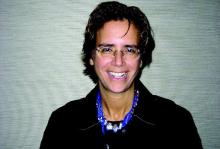SAN FRANCISCO – Use of intraoperative nerve monitoring during thyroidectomy to avoid injuring the recurrent laryngeal nerve is counterintuitively associated with a higher risk of vocal cord paralysis, in a cohort study of data from the Nationwide Inpatient Sample.
“We do caution against perhaps the broad adoption of nerve monitoring until we can really study this further,” said Dr. Thomas K. Chung, a research fellow in the department of surgery, division of otolaryngology, at the University of Alabama at Birmingham, and the study’s lead investigator.
He and his colleagues compared outcomes between 12,742 patients who had nerve monitoring and 230,433 patients who did not (the conventional practice) while undergoing thyroidectomy between 2008 and 2011.
The proportion of patients who developed vocal cord paralysis was significantly higher with monitoring than without it (1.9% vs. 1.4%), he reported at the annual clinical congress of the American College of Surgeons. The findings were essentially the same in propensity-adjusted analyses that took into account differences between groups in preoperative factors (1.8% vs. 1.3%).
There was no evidence that the difference was related to differences in the use of laryngoscopy to check for paralysis, in hospitals’ coding and billing for monitoring, or in payers’ coverage of this surgical adjunct.
Stratified analyses looking at the extent of surgery showed total thyroidectomy with neck dissection to be the exception, as patients monitored during these more complex operations were significantly less likely to develop vocal cord paralysis than were nonmonitored counterparts (2.8% vs. 4.5%).
The more often hospitals used nerve monitoring as indicated by the volume of thyroidectomy cases, the lower the rate of vocal cord paralysis – with the exception of cases of partial thyroidectomy, in which more frequent use was associated with a counterintuitive increase in the rate of this complication, according to Dr. Chung, who disclosed that he had no relevant conflicts of interest.
“Nerve monitoring demonstrates a significant benefit particularly in complex cases such as total thyroidectomy with neck dissection,” he said. “Low nerve monitoring and utilization with partial thyroidectomy appears to be associated with higher vocal cord paralysis; with respect to the partial thyroidectomies, this may be due to the fact that the burden of complication is already so low, with vocal cord paralysis rates of about 0.8%, that additional use of nerve monitoring may not confer any benefit.”
Dr. Chung offered several possible reasons as to why monitoring may be associated with a higher risk of vocal cord paralysis, including presence of a learning curve, substitution of monitoring for direct visualization of the nerve, and false-negatives whereby a lack of signal from the monitor may lead to more aggressive ablation when the nerve is in fact nearby.
The study had its limitations, he acknowledged. “Nerve monitoring may not be coded all the time,” he said. Information about prior neck radiation and surgery, which increase the risk of vocal cord paralysis, was unavailable. “In the group with thyroidectomy with neck dissection, there is no code for central neck dissection. And even if it is a partial thyroidectomy with neck dissection, the central neck dissection would put both nerves at risk and therefore certainly increase the risk of vocal cord paralysis,” he noted.
Invited discussant Julie Ann Sosa, chief of endocrine surgery at the Duke Cancer Institute in Durham, N.C., said, “I would like to congratulate you and your whole group for tackling what is perhaps one of the most highly contested and contentious issues within endocrine surgery and otolaryngology. It’s also I think a very important area for study because there is a relative paucity of data demonstrating for or against the use of this technology as an adjunct. Current guidelines basically say it’s a wash: We can’t say one way or the other whether folks should be using it. And the anticipated guidelines, those coming out from the American Thyroid Association, similarly will say that more data are needed. So I think you are filling a clear vacuum.”
Dr. Sosa questioned the generalizability of the findings, noting that nearly two-thirds of thyroid procedures are now done in the ambulatory setting. “You used the Nationwide Inpatient Sample, so I think you are looking at a minority of cases and highly complex cases, with a length of stay on the order of 2-3 days, which is really exceptional. Most of us send home patients the same day. So how generalizable do you think your conclusions are, and have you thought about potentially using some of the ambulatory surgery databases to try to ask similar questions?” she queried.


